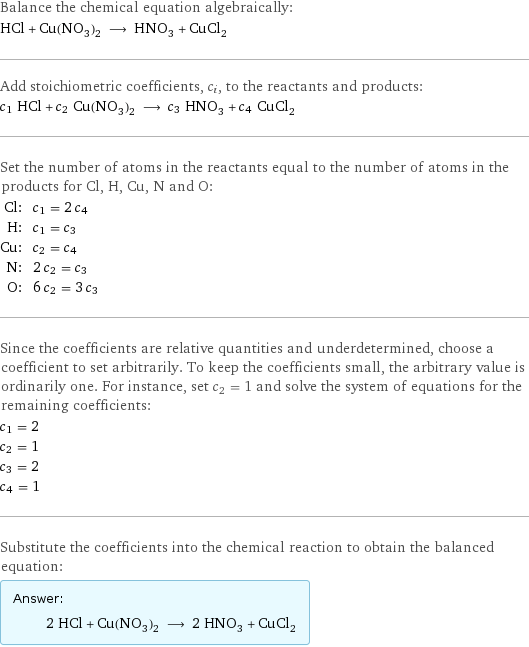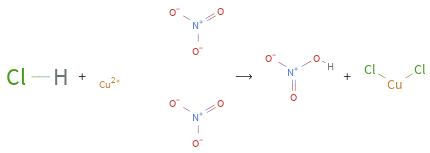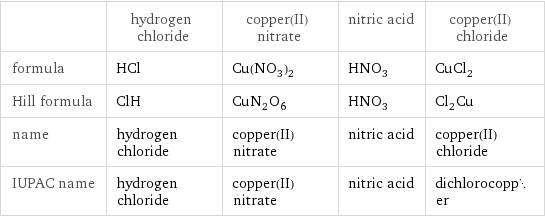Input interpretation

HCl hydrogen chloride + Cu(NO_3)_2 copper(II) nitrate ⟶ HNO_3 nitric acid + CuCl_2 copper(II) chloride
Balanced equation

Balance the chemical equation algebraically: HCl + Cu(NO_3)_2 ⟶ HNO_3 + CuCl_2 Add stoichiometric coefficients, c_i, to the reactants and products: c_1 HCl + c_2 Cu(NO_3)_2 ⟶ c_3 HNO_3 + c_4 CuCl_2 Set the number of atoms in the reactants equal to the number of atoms in the products for Cl, H, Cu, N and O: Cl: | c_1 = 2 c_4 H: | c_1 = c_3 Cu: | c_2 = c_4 N: | 2 c_2 = c_3 O: | 6 c_2 = 3 c_3 Since the coefficients are relative quantities and underdetermined, choose a coefficient to set arbitrarily. To keep the coefficients small, the arbitrary value is ordinarily one. For instance, set c_2 = 1 and solve the system of equations for the remaining coefficients: c_1 = 2 c_2 = 1 c_3 = 2 c_4 = 1 Substitute the coefficients into the chemical reaction to obtain the balanced equation: Answer: | | 2 HCl + Cu(NO_3)_2 ⟶ 2 HNO_3 + CuCl_2
Structures

+ ⟶ +
Names

hydrogen chloride + copper(II) nitrate ⟶ nitric acid + copper(II) chloride
Equilibrium constant
![Construct the equilibrium constant, K, expression for: HCl + Cu(NO_3)_2 ⟶ HNO_3 + CuCl_2 Plan: • Balance the chemical equation. • Determine the stoichiometric numbers. • Assemble the activity expression for each chemical species. • Use the activity expressions to build the equilibrium constant expression. Write the balanced chemical equation: 2 HCl + Cu(NO_3)_2 ⟶ 2 HNO_3 + CuCl_2 Assign stoichiometric numbers, ν_i, using the stoichiometric coefficients, c_i, from the balanced chemical equation in the following manner: ν_i = -c_i for reactants and ν_i = c_i for products: chemical species | c_i | ν_i HCl | 2 | -2 Cu(NO_3)_2 | 1 | -1 HNO_3 | 2 | 2 CuCl_2 | 1 | 1 Assemble the activity expressions accounting for the state of matter and ν_i: chemical species | c_i | ν_i | activity expression HCl | 2 | -2 | ([HCl])^(-2) Cu(NO_3)_2 | 1 | -1 | ([Cu(NO3)2])^(-1) HNO_3 | 2 | 2 | ([HNO3])^2 CuCl_2 | 1 | 1 | [CuCl2] The equilibrium constant symbol in the concentration basis is: K_c Mulitply the activity expressions to arrive at the K_c expression: Answer: | | K_c = ([HCl])^(-2) ([Cu(NO3)2])^(-1) ([HNO3])^2 [CuCl2] = (([HNO3])^2 [CuCl2])/(([HCl])^2 [Cu(NO3)2])](../image_source/f72e62befdd3c8b9eb7b52ac7b5984db.png)
Construct the equilibrium constant, K, expression for: HCl + Cu(NO_3)_2 ⟶ HNO_3 + CuCl_2 Plan: • Balance the chemical equation. • Determine the stoichiometric numbers. • Assemble the activity expression for each chemical species. • Use the activity expressions to build the equilibrium constant expression. Write the balanced chemical equation: 2 HCl + Cu(NO_3)_2 ⟶ 2 HNO_3 + CuCl_2 Assign stoichiometric numbers, ν_i, using the stoichiometric coefficients, c_i, from the balanced chemical equation in the following manner: ν_i = -c_i for reactants and ν_i = c_i for products: chemical species | c_i | ν_i HCl | 2 | -2 Cu(NO_3)_2 | 1 | -1 HNO_3 | 2 | 2 CuCl_2 | 1 | 1 Assemble the activity expressions accounting for the state of matter and ν_i: chemical species | c_i | ν_i | activity expression HCl | 2 | -2 | ([HCl])^(-2) Cu(NO_3)_2 | 1 | -1 | ([Cu(NO3)2])^(-1) HNO_3 | 2 | 2 | ([HNO3])^2 CuCl_2 | 1 | 1 | [CuCl2] The equilibrium constant symbol in the concentration basis is: K_c Mulitply the activity expressions to arrive at the K_c expression: Answer: | | K_c = ([HCl])^(-2) ([Cu(NO3)2])^(-1) ([HNO3])^2 [CuCl2] = (([HNO3])^2 [CuCl2])/(([HCl])^2 [Cu(NO3)2])
Rate of reaction
![Construct the rate of reaction expression for: HCl + Cu(NO_3)_2 ⟶ HNO_3 + CuCl_2 Plan: • Balance the chemical equation. • Determine the stoichiometric numbers. • Assemble the rate term for each chemical species. • Write the rate of reaction expression. Write the balanced chemical equation: 2 HCl + Cu(NO_3)_2 ⟶ 2 HNO_3 + CuCl_2 Assign stoichiometric numbers, ν_i, using the stoichiometric coefficients, c_i, from the balanced chemical equation in the following manner: ν_i = -c_i for reactants and ν_i = c_i for products: chemical species | c_i | ν_i HCl | 2 | -2 Cu(NO_3)_2 | 1 | -1 HNO_3 | 2 | 2 CuCl_2 | 1 | 1 The rate term for each chemical species, B_i, is 1/ν_i(Δ[B_i])/(Δt) where [B_i] is the amount concentration and t is time: chemical species | c_i | ν_i | rate term HCl | 2 | -2 | -1/2 (Δ[HCl])/(Δt) Cu(NO_3)_2 | 1 | -1 | -(Δ[Cu(NO3)2])/(Δt) HNO_3 | 2 | 2 | 1/2 (Δ[HNO3])/(Δt) CuCl_2 | 1 | 1 | (Δ[CuCl2])/(Δt) (for infinitesimal rate of change, replace Δ with d) Set the rate terms equal to each other to arrive at the rate expression: Answer: | | rate = -1/2 (Δ[HCl])/(Δt) = -(Δ[Cu(NO3)2])/(Δt) = 1/2 (Δ[HNO3])/(Δt) = (Δ[CuCl2])/(Δt) (assuming constant volume and no accumulation of intermediates or side products)](../image_source/1fd4f821d04fbb30d8b1c3b0fa57febe.png)
Construct the rate of reaction expression for: HCl + Cu(NO_3)_2 ⟶ HNO_3 + CuCl_2 Plan: • Balance the chemical equation. • Determine the stoichiometric numbers. • Assemble the rate term for each chemical species. • Write the rate of reaction expression. Write the balanced chemical equation: 2 HCl + Cu(NO_3)_2 ⟶ 2 HNO_3 + CuCl_2 Assign stoichiometric numbers, ν_i, using the stoichiometric coefficients, c_i, from the balanced chemical equation in the following manner: ν_i = -c_i for reactants and ν_i = c_i for products: chemical species | c_i | ν_i HCl | 2 | -2 Cu(NO_3)_2 | 1 | -1 HNO_3 | 2 | 2 CuCl_2 | 1 | 1 The rate term for each chemical species, B_i, is 1/ν_i(Δ[B_i])/(Δt) where [B_i] is the amount concentration and t is time: chemical species | c_i | ν_i | rate term HCl | 2 | -2 | -1/2 (Δ[HCl])/(Δt) Cu(NO_3)_2 | 1 | -1 | -(Δ[Cu(NO3)2])/(Δt) HNO_3 | 2 | 2 | 1/2 (Δ[HNO3])/(Δt) CuCl_2 | 1 | 1 | (Δ[CuCl2])/(Δt) (for infinitesimal rate of change, replace Δ with d) Set the rate terms equal to each other to arrive at the rate expression: Answer: | | rate = -1/2 (Δ[HCl])/(Δt) = -(Δ[Cu(NO3)2])/(Δt) = 1/2 (Δ[HNO3])/(Δt) = (Δ[CuCl2])/(Δt) (assuming constant volume and no accumulation of intermediates or side products)
Chemical names and formulas

| hydrogen chloride | copper(II) nitrate | nitric acid | copper(II) chloride formula | HCl | Cu(NO_3)_2 | HNO_3 | CuCl_2 Hill formula | ClH | CuN_2O_6 | HNO_3 | Cl_2Cu name | hydrogen chloride | copper(II) nitrate | nitric acid | copper(II) chloride IUPAC name | hydrogen chloride | copper(II) nitrate | nitric acid | dichlorocopper
Substance properties

| hydrogen chloride | copper(II) nitrate | nitric acid | copper(II) chloride molar mass | 36.46 g/mol | 187.55 g/mol | 63.012 g/mol | 134.4 g/mol phase | gas (at STP) | | liquid (at STP) | solid (at STP) melting point | -114.17 °C | | -41.6 °C | 620 °C boiling point | -85 °C | | 83 °C | density | 0.00149 g/cm^3 (at 25 °C) | | 1.5129 g/cm^3 | 3.386 g/cm^3 solubility in water | miscible | | miscible | dynamic viscosity | | | 7.6×10^-4 Pa s (at 25 °C) |
Units
